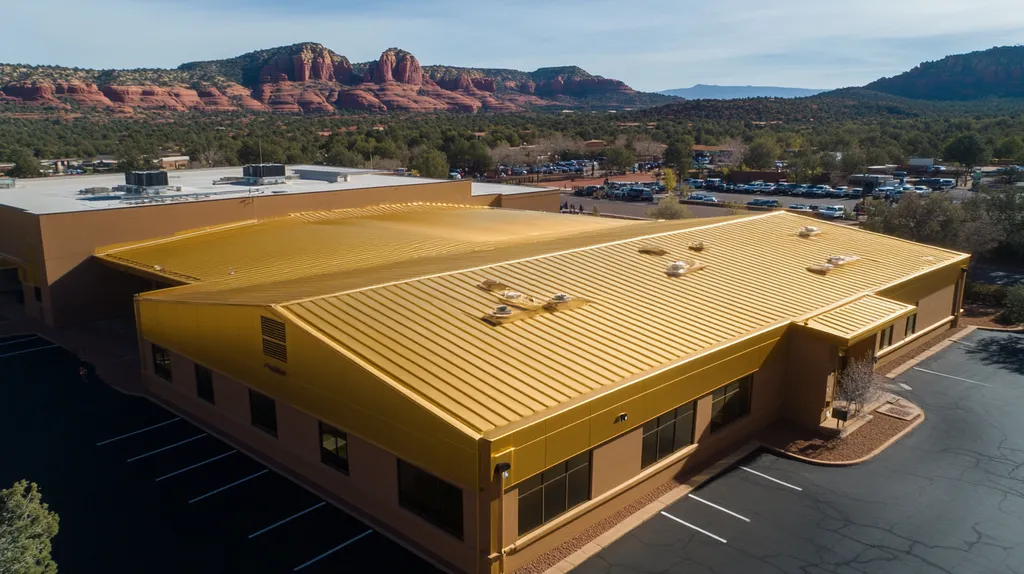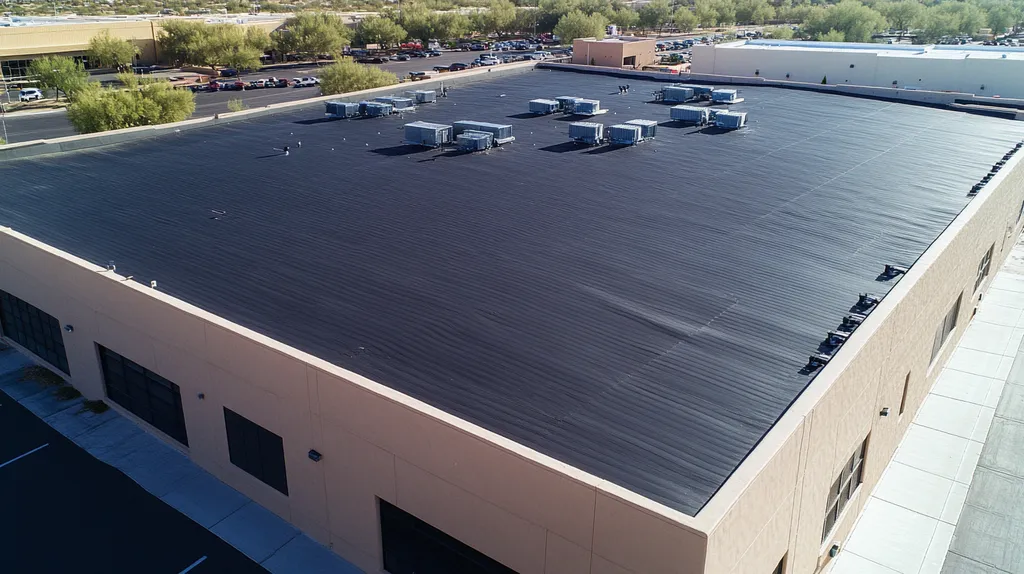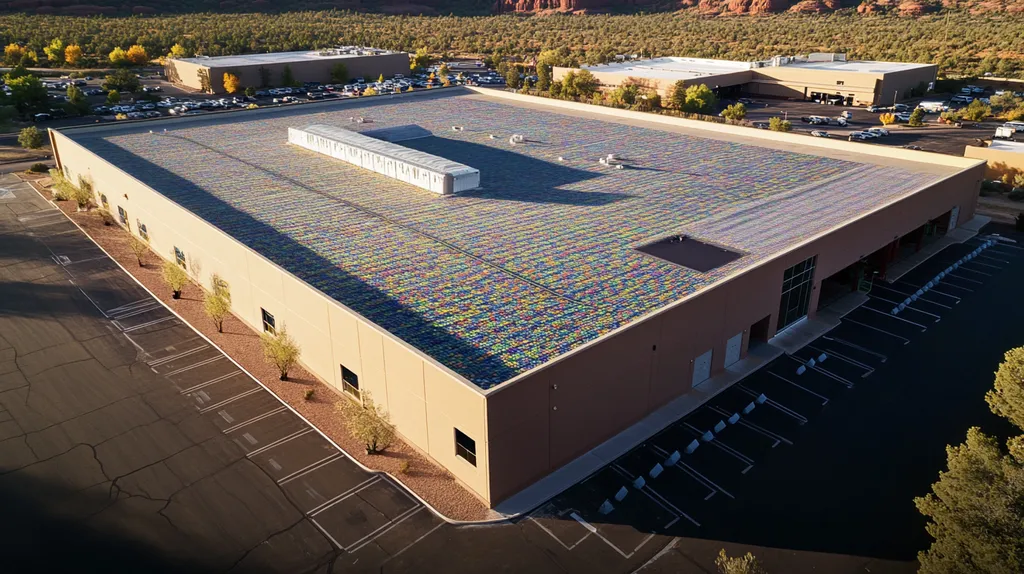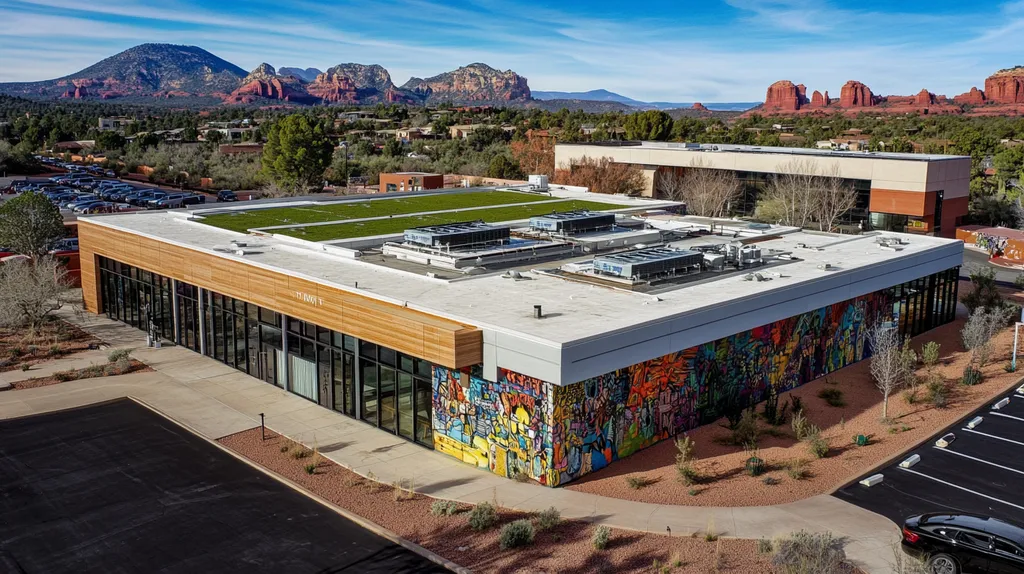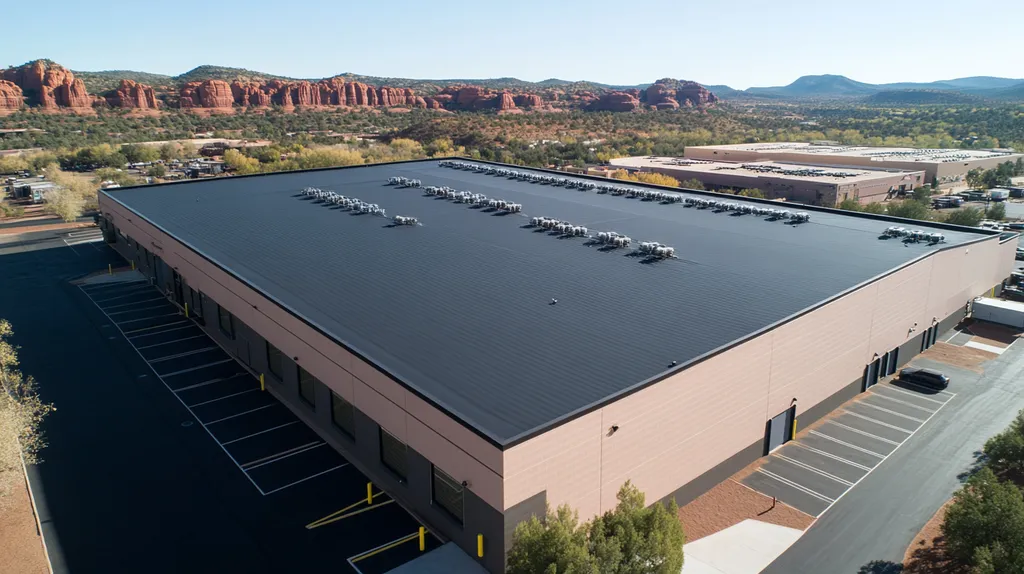In the high-stakes world of commercial roofing, one overlooked regulation can spiral into $50,000 or more in repairs, fines, and business disruption. Every year, thousands of building owners face costly retrofits simply because they missed a critical code requirement during installation.
From fire resistance ratings to wind uplift standards, today’s commercial roofs must navigate an increasingly complex maze of local, state, and federal regulations. Even seemingly minor violations can trigger failed inspections, permit revocations, or insurance claim denials.
This comprehensive guide breaks down the essential regulations affecting commercial roof installations, helping property owners and facility managers avoid common compliance pitfalls while optimizing their roofing investments.
SECTION 1: FUNDAMENTAL CONCEPTS
Think your commercial roof is just hanging out up there, minding its own business? Think again! Every day, building owners dance through a complex maze of regulations that can make or break their roofing projects. Did you know that a single overlooked building code can turn your roof installation into a costly game of “fix-it-again”? Let’s face it – understanding local regulations isn’t just paperwork gymnastics; it’s your ticket to avoiding those dreaded midnight calls about leaks, fines, or worse.
Overview of Local Building Codes Impacting Roofing
Local building codes are like your roof’s rulebook – they tell you what moves are legal and what moves might land you in hot water. These codes aren’t just arbitrary rules invented to make life interesting; they’re your building’s survival guide.
Picture this: in sunny Phoenix, your roof needs to handle scorching heat like a champ, while in Miami, it better be ready for hurricane-force dance parties. Each location has its own special requirements, and they’re not just suggestions!
Energy codes are getting pickier by the day, demanding roofs that reflect more heat than a disco ball. Some cities even require “cool roof” ratings that would make a polar bear comfortable.
Even the materials you choose need to play by local rules. That bargain roofing material might look great on paper, but if it doesn’t meet your area’s fire resistance requirements, it’s about as useful as an umbrella made of paper.
Legal Requirements for Commercial Roof Installations
Let’s talk legal jazz – the kind that keeps your roof legitimate and your wallet happy. Beyond basic building codes, there’s a whole orchestra of regulations playing together to keep your roof in harmony with local laws.
Worker safety regulations aren’t optional extras – they’re like the guardrails that keep your project from taking an unfortunate tumble. OSHA requirements must be met, or your project could screech to an expensive halt.
Environmental regulations are getting stricter than a librarian during finals week. From proper disposal of old roofing materials to managing runoff during installation, Mother Nature has her own rulebook.
Insurance requirements add another layer to consider. Your coverage needs to be as solid as your roof, or you might find yourself caught in a storm without an umbrella.
Understanding Permit Processes and Documentation
Ready for some permit paperwork party planning? Almost all roofing projects require a permit before work begins, especially commercial installations. These aren’t just fancy pieces of paper – they’re your golden ticket to a legally sound roof.
The permit process involves more plot twists than a mystery novel. You’ll need detailed plans, structural calculations, and material specifications that meet local building department requirements.
Inspections will become your new best friends – they’ll visit before, during, and after construction to ensure everything’s up to snuff. Skip these check-ins, and you might find yourself with an expensive do-over on your hands.
Documentation is your roofing project’s memory bank – keep it organized and accessible. These records protect your investment and prove compliance when needed. (source: PermitFlow)
SECTION 2: SYSTEM COMPONENTS
Think your commercial roof is just a giant jigsaw puzzle of materials slapped together? Think again! Every component of your roofing system needs to play by the rules – and those rules can change faster than weather in springtime. One wrong material choice or missed structural requirement can turn your roof from a stalwart defender into a liability magnet. Let’s dive into the fascinating world of roofing components, where even the tiniest detail can make the difference between a roof that protects and one that protests!
Code-Compliant Roofing Materials and Specifications
Welcome to the material world of commercial roofing, where not all components are created equal! Your local building codes have strong opinions about what belongs on your roof, and they’re not afraid to share them. Some materials might look perfect on paper but fold faster than a house of cards when faced with your region’s specific challenges.
The City of Dayton reminds us that while some re-roofing projects can skip the permit dance, anything involving structural changes needs official blessing before the first nail goes in. This seemingly simple detail can save you from costly do-overs and legal headaches down the road.
Think you can mix and match materials like a buffet line? Not so fast! Each component needs to play nice with its neighbors, creating a harmonious system that meets or exceeds local standards. That bargain membrane might look tempting, but if it doesn’t meet your area’s wind uplift requirements, it’s about as useful as an umbrella in a tornado.
Your roofing materials should be like a well-trained orchestra – each piece working in perfect harmony to create something greater than the sum of its parts. (source: City of Dayton)
Structural Considerations under Local Regulations
Let’s talk about the backbone of your roofing system – the structure that keeps everything from turning into a giant slip-n-slide! Your local codes have specific ideas about load-bearing requirements, and they’re not just being picky. These requirements are your roof’s personal trainer, making sure it’s strong enough to handle whatever Mother Nature throws its way.
Dead loads, live loads, snow loads – it sounds like a weight-lifting competition, doesn’t it? But these calculations determine whether your roof will stand strong or stumble under pressure. Different regions demand different muscle, and your structural components need to flex accordingly.
Drainage isn’t just about keeping the water flowing – it’s about preventing your roof from turning into an accidental swimming pool. Proper slope, adequate drainage paths, and strategic placement of outlets can mean the difference between a dry building and an indoor waterpark.
Don’t forget about those sneaky thermal movements! Your roof expands and contracts like a breathing giant, and your structure needs to accommodate these changes without throwing a fit. Proper expansion joints and flexibility in the right places keep everything moving smoothly.
Fire Resistance and Energy Efficiency Standards
Ready to turn up the heat on fire safety? Your roof needs to be more flame-resistant than a dragon’s scales! Fire ratings aren’t just fancy letters – they’re your building’s survival strategy when things get hot. The difference between Class A and Class C could be the difference between a minor incident and a major disaster.
Energy efficiency isn’t just about being green – it’s about keeping your building cool while your utility bills chill out. Today’s roofing systems need to reflect more heat than a mirror in the desert. Solar reflectance, thermal emittance, and heat island reduction all play starring roles in this energy-saving drama.
Cool roofs are the new hot trend, and for good reason! They can slash your cooling costs faster than a discount sale, all while helping your building meet increasingly strict energy codes. Some cities even offer incentives for installing these energy-savvy systems.
Remember, fire resistance and energy efficiency aren’t just boxes to check – they’re investments in your building’s future. A well-designed system that meets these standards can pay dividends in lower insurance premiums, reduced energy costs, and improved building safety.
SECTION 3: IMPLEMENTATION METHODS
Think installing a commercial roof is just about laying down materials and calling it a day? Think again! Every nail, every seam, and every square foot needs to dance to the tune of local regulations. One misstep in the implementation process can turn your roofing project into an expensive game of “fix-it-later.” Let’s navigate through the implementation maze that turns good intentions into great installations!
Permit Application and Approval Workflow
Ready to dive into the permit process? It’s like a treasure hunt where X marks the spot – except X is your building department’s approval stamp! Starting without proper permits is like skydiving without a parachute – thrilling briefly, but with predictably expensive consequences.
Your permit application needs more supporting documentation than a presidential candidate needs votes. Building plans, material specifications, structural calculations – they all need to line up like perfect dominos before that first shingle goes anywhere.
Different jurisdictions have different permit requirements, and they’re about as flexible as concrete. Some might want energy calculations that would make Einstein scratch his head, while others focus on wind resistance ratings that could challenge a tornado.
Timeline management is crucial – permits don’t appear magically overnight. Plan for review periods that can stretch longer than a summer vacation, and build these into your project schedule like load-bearing beams.
Inspection Procedures During Roofing Installation
Warning lines, safety barriers, and designated work zones aren’t just suggestions – they’re your roof’s VIP security system. These safety measures must be precisely placed and maintained throughout the installation process.
In California, warning lines must keep their distance – staying at least 5 feet from roof edges during operations. Equipment operation near edges follows stricter rules than a championship chess match. (source: California Code of Regulations)
Inspection checkpoints pop up more frequently than summer construction zones. Pre-installation inspections check your homework, progress inspections make sure you’re staying on track, and final inspections put the gold star on your project.
Documentation during inspections should be more detailed than a detective’s case file. Photos, measurements, material verifications – everything needs to be recorded as if you’re writing the definitive history of your roof.
Ensuring Compliance Through Construction Practices
Your roofing project needs more coordination than a marching band at halftime! Every contractor, every worker, and every supplier needs to move in perfect harmony with local regulations.
Quality control isn’t just a fancy phrase – it’s your roof’s personal bodyguard. Material storage, application techniques, and weather monitoring all need to follow guidelines stricter than a five-star restaurant’s health code.
Communication flows should be clearer than a cloudless sky. Daily briefings, progress reports, and compliance checks help catch small issues before they grow into big problems.
Keep your documentation organized better than a librarian with OCD. Every material delivery, every inspection result, and every modification needs its own permanent record – because in the world of commercial roofing, if it isn’t documented, it didn’t happen.
SECTION 4: MAINTENANCE REQUIREMENTS
Think your roof maintenance schedule is just a suggestion? Think again! Every day your commercial roof faces an assault from the elements while trying to meet strict regulatory requirements. Without proper maintenance, even minor issues can snowball into major compliance violations faster than a leak spreads across your ceiling. Let’s explore how staying on top of maintenance requirements keeps your roof legal, your building protected, and your budget from springing unexpected leaks!
Regulatory Guidelines for Roof Inspection and Repair
Your commercial roof isn’t just sitting pretty up there – it’s got some serious responsibilities! Regular inspections aren’t optional extras; they’re your roof’s mandatory check-ups to stay in compliance with local regulations.
Metal panel and tile roofing systems demand special attention to wind resistance requirements, especially in areas prone to severe weather. These components need regular verification to ensure they still meet design wind speed criteria and exposure requirements to maintain safety compliance.
Attachment methods that seemed secure during installation can loosen over time, demanding thorough documentation and regular verification against approved standards. Even minor shifts can trigger major compliance issues if left unchecked.
Different regions have their own strict approval benchmarks – from Miami-Dade specifications to state-specific product approvals – that your maintenance program must address to stay compliant. (source: Insurance Institute for Business & Home Safety)
Documentation and Reporting for Code Compliance
Ready to become best friends with your filing system? Documentation isn’t just busywork – it’s your shield against compliance headaches and your proof of due diligence when questions arise.
Every inspection needs more detail than a detective’s case file. Record dates, findings, repairs, and even those “all clear” results – because in the world of regulatory compliance, if it isn’t documented, it might as well never have happened.
Create a maintenance timeline that’s more organized than a librarian’s card catalog. Track upcoming inspections, past repairs, and future maintenance needs in a system that’s easier to navigate than your building’s floor plan.
Digital tracking systems aren’t just fancy toys – they’re your maintenance schedule’s best friend. These tools can alert you to upcoming requirements, store historical data, and generate reports faster than you can say “building inspector.”
Addressing Code-Related Safety and Performance Issues
Safety issues don’t send appointment reminders – they just show up uninvited and demand immediate attention! Catching problems early through regular maintenance isn’t just smart; it’s your legal obligation as a building owner.
Your roof’s drainage system needs more attention than a toddler in a candy store. Blocked drains, compromised seals, and poor ventilation aren’t just annoyances – they’re potential code violations waiting to happen.
Keep your emergency response plan sharper than a tack. When issues arise, having pre-approved contractors and documented procedures ready can mean the difference between a quick fix and a compliance nightmare.
Regular maintenance checks should be as routine as your morning coffee. These inspections help spot potential problems before they evolve into violations that could cost more than your annual maintenance budget.
SECTION 5: PERFORMANCE METRICS
Think measuring your roof’s performance is just about checking for leaks? Think again! Your commercial roof is constantly being graded on everything from its energy efficiency to its fire resistance, and failing these tests can cost you big time. Just like a student facing final exams, your roof needs to prove it’s making the grade on multiple subjects – and the stakes are higher than a penthouse suite!
Measuring Compliance with Energy and Fire Codes
Your roof’s energy performance needs to be measured more precisely than a master chef’s ingredients. Modern building codes demand specific reflectivity ratings, insulation values, and thermal performance metrics that would make a physicist proud.
Fire resistance testing isn’t just about seeing if something burns – it’s a sophisticated analysis of flame spread, penetration resistance, and structural integrity under extreme conditions. Your roof needs to pass these tests with flying colors, not just squeak by with a passing grade.
The City of Novi Community Development Department requires detailed documentation including manufacturer product listings and fire spread documentation before they’ll even consider your roofing permit. Get these metrics wrong, and your project won’t make it past the starting line. (source: City of Novi Community Development Department)
Regular performance testing isn’t just bureaucratic busy work – it’s your early warning system for potential compliance issues. Think of it as your roof’s report card, showing exactly where it excels and where it needs improvement.
Structural Integrity Assessments in Regulatory Context
Your roof’s structural integrity metrics are like its vital signs – they tell you whether it’s healthy enough to keep doing its job. Load-bearing calculations, deflection measurements, and stress analysis need to be as precise as a surgeon’s instruments.
Weather resistance metrics aren’t just about surviving the next storm – they’re about proving your roof can handle whatever Mother Nature throws at it for years to come. Wind uplift resistance, impact resistance, and water penetration resistance all need regular checkups.
Structural assessment data needs to be tracked more carefully than a bank tracks its money. Every inspection, every test result, and every modification needs proper documentation to prove your roof isn’t just standing there – it’s standing there legally.
Don’t forget about seismic considerations! In many areas, your roof needs to prove it can dance to earth’s occasional shimmy without missing a beat.
Tracking Long-Term Durability as per Standards
Durability tracking is like your roof’s fitness monitoring system – it helps predict how long components will last and when they might need replacement. Different materials age at different rates, and tracking these changes helps prevent surprise failures.
Performance degradation metrics need to be monitored more closely than a championship sports team’s statistics. Changes in material flexibility, water resistance, and thermal properties can signal brewing trouble before it becomes a crisis.
Your maintenance schedule should be based on hard data, not hunches. Regular measurement of wear patterns, material fatigue, and environmental impact helps optimize repair timing and prevent costly emergency fixes.
Documentation of these metrics isn’t just paperwork – it’s your roof’s biography, telling the story of how it’s holding up against time, weather, and wear. Keep these records cleaner than a laboratory and more organized than a library catalog.
SECTION 6: OPTIMIZATION STRATEGIES
Think your commercial roof is just following the rules? Think again! Smart optimization of roofing regulations can transform your building’s performance faster than a solar panel soaking up sunshine. While some property owners see codes as hurdles to jump, savvy managers are turning these requirements into trampolines – launching their buildings toward better efficiency, lower costs, and smoother operations. Let’s explore how playing by the rules can actually help you win the game!
Leveraging Local Codes for Energy Savings
Ready to turn those intimidating energy codes into your building’s secret weapon? Local requirements aren’t just regulatory hoops – they’re your roadmap to slashing utility bills and boosting property value!
Modern energy codes are pickier than a food critic at a fast-food joint. But their strict requirements for insulation values, reflective ratings, and thermal performance can translate directly into lower monthly bills.
Smart property managers are discovering that going beyond minimum requirements often pays for itself faster than you can say “utility rebate.” Many jurisdictions offer incentives that can offset up to 30% of upgrade costs.
Even simple adjustments like strategic material selection or improved installation techniques can amplify your energy savings while keeping inspectors happier than kids in a candy store.
Integrating Sustainable and Code-Approved Materials
Metal panels and clay tiles aren’t just playing dress-up on your roof – they need proper credentials to attend this party! Each component must meet specific wind resistance standards and product approvals that vary by location and exposure conditions.
In high-wind regions, your roofing materials need to be tougher than a bodybuilder’s workout routine. Wind uplift resistance requirements start at 110 mph Vasd/140 mph Vult, with underlayments meeting strict ASTM testing standards. (source: Insurance Institute for Business & Home Safety)
Sustainable materials aren’t just trendy – they’re becoming mandatory fashion in many jurisdictions. From recycled components to locally sourced materials, going green is increasingly the only way to stay in code compliance.
The key is finding materials that check both the sustainability and compliance boxes without emptying your wallet. Modern options often deliver better performance while meeting stricter environmental standards.
Navigating Regulatory Updates for Continuous Compliance
Building codes change more often than fashion trends, and staying current requires more attention than a puppy in a toy store. Creating a systematic approach to tracking updates can prevent costly surprises.
Digital tracking systems have become sharper than a detective’s magnifying glass at spotting upcoming changes. These tools can alert you to new requirements before they become urgent compliance issues.
Building strong relationships with local code officials is like having a backstage pass to regulatory changes. Regular communication can give you advance notice of upcoming modifications, letting you plan rather than scramble.
Remember that compliance isn’t a one-time achievement – it’s an ongoing process that needs more attention than a garden in spring. Regular audits and updates keep your roof performing at its peak while staying ahead of regulatory curves.
The Bottom Line
With commercial roofing violations costing businesses over $500 million annually in fines and repairs, staying ahead of regulations isn’t just smart – it’s essential for survival.
Local codes and requirements continue evolving at a dizzying pace, with over 40% of jurisdictions updating their standards every three years.
Success demands a proactive approach: maintaining detailed documentation, implementing regular inspection schedules, and optimizing systems for both compliance and performance.
The most successful property owners treat regulations not as obstacles, but as frameworks for creating safer, more efficient, and more valuable buildings.
In today’s complex regulatory environment, knowledge of local codes isn’t just about avoiding penalties – it’s about transforming compliance into a competitive advantage.
FREQUENTLY ASKED QUESTIONS
Q. What local regulations impact my commercial roof installation?
A. Local regulations dictate specific requirements that ensure your roof meets safety and efficiency standards. These can include building codes, energy codes, and fire resistance ratings tailored to your region’s environmental challenges. Ignoring these rules may result in significant liabilities and costly repairs.
Q. How do building codes affect my industrial roof materials?
A. Building codes have strict guidelines on materials that ensure they can withstand local climate variables, including wind and water resistance. Certain materials may not be compliant, which could open the door to leaks and other long-term issues. Always choose materials certified to meet these standards!
Q. What is the importance of inspections during a commercial roof installation?
A. Inspections are crucial checkpoints to ensure compliance with local regulations throughout the installation. They verify that the materials and workmanship meet safety standards, helping prevent costly mistakes. Missing inspections can lead to fines or the need for rework, so consider them imperative.
Q. How often should I inspect my commercial roof for maintenance?
A. Regular inspections should be scheduled at least twice a year, plus after severe weather events. This routine helps identify wear and tear early, ensuring your roof remains compliant and functional. Ignoring regular maintenance can unravel a string of costly compliance issues in no time!
Q. What performance metrics should I track for my commercial roof?
A. Key metrics include energy efficiency, water penetration resistance, and structural integrity assessments. Monitoring these aspects ensures your roof meets performance standards. Failing to track these metrics can lead to unanticipated failures and compliance headaches down the road!
Q. How can I optimize my roof to save on energy costs?
A. To optimize your roof for energy savings, leverage local energy codes for improved insulation and reflective materials. Going beyond the minimum requirements can yield significant long-term savings and boost your property value. Consider these improvements your secret weapon against high utility bills!
Q. What new regulations should I be aware of for my commercial roof?
A. Stay informed about evolving building codes, especially those addressing sustainability and energy efficiency. New regulations might require strict adherence to the use of eco-friendly materials or stricter energy performance metrics. Regularly checking for updates ensures your roof remains compliant and valuable to your property.

